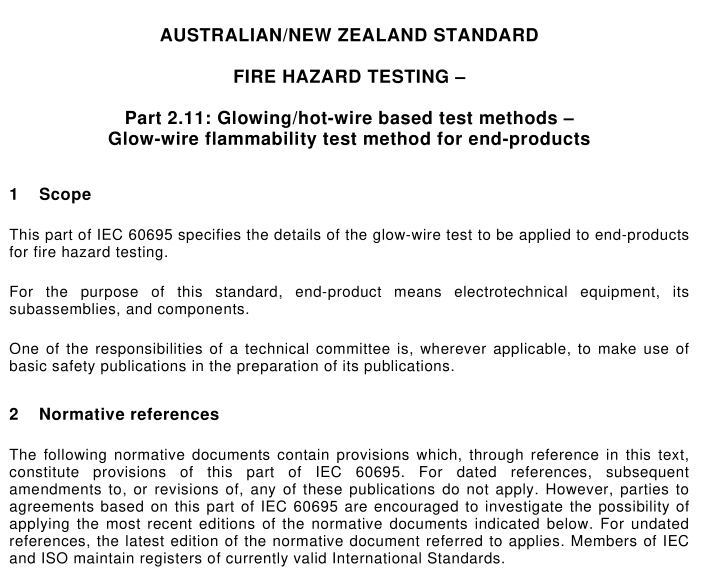AS NZS 60695.2.11 pdf download – Fire hazard testing – Part 2.1 1 : Glowing/hot wire based test methods – Glow-wire flammability test method for end-products (IEC 60695-2-1 1 :2000, MOD)

AS NZS 60695.2.11 pdf download Fire hazard testing – Part 2.1 1 : Glowing/hot wire based test methods – Glow-wire flammability test method for end-products (IEC 60695-2-1 1 :2000, MOD)
4 Description of test considerations and test specimen selection If possible, the test specimen should be a complete end-product. The test specimen shall be chosen so that the conditions of the test will not be significantly different from those occurring in normal use with regard to shape, ventilation, effect of thermal stresses and, possibly, of flames occurring in, or of burning or glowing particles falling in the vicinity of, the test specimen. If the test cannot be made on a complete end-product, or unless otherwise specified by the relevant specification, it is acceptable to
a) cut a piece containing the part under examination from it, or
b) cut an aperture in the complete end-product to allow the glow-wire access, or
c) remove the part under examination in its entirety and test it separately. Technical committees should define in their relevant specifications what may be removed to achieve access.
A small aperture may affect the results by leading to the ignition of the surroundings, by reducing the temperature of the glow-wire or by restricting the availability of oxygen, whereas too large an aperture may permit more oxygen than would normally be available. If, during the test, any part of the equipment containing the test specimen is ignited by extraneous heat from the glow-wire and so influences the thermal conditions at the test specimen, the test shall be invalid.
The test is carried out to ensure that, under defined conditions, the glow-wire does not cause ignition of parts, and that a part, if ignited, has a limited duration of burning without spreading fire by flames or by burning or glowing particles falling from the test specimen.
If the test specimen emits flames during the application of the glow-wire, the fire hazard created may necessitate further tests using other ignition sources such as the needle-flame applied to those parts which are reached by the emitted flames. The glow-wire test shall not be used for small parts for which reference may need to be made to other test methods, for example, the needle-flame test in IEC 60695-2-2.
5 Description of the test apparatus
The description of the test apparatus is given in clause 5 of IEC 60695-2-1 0. To evaluate the possibility of spread of fire, for example, by burning or glowing particles falling from the test specimen, a specified layer as described in 5.3 of IEC 60695-2-1 0, or the material or components normally surrounding or situated underneath the test specimen, is placed underneath the test specimen.
The distances between the test specimen and the specified layer representing the surrounding material or components, shall be equal to those when the test specimen is mounted in the electrotechnical product. If the test specimen is a complete free-standing equipment, it is placed in its normal position of use on the specified layer as described in clause 5.3 of IEC 60695-2-1 0 extending for at least 1 00 mm outside the base of the equipment in all directions. If the test specimen is a complete wall-mounted equipment, it is fixed in its normal position of use 200 mm ± 5 mm above the specified layer as described in 5.3 of IEC 60695-2-1 0.
6 Severities The test temperature shall be chosen from the following values of table 1 .
If required by the relevant specification, other test temperatures may be used.
NOTE See annex A for guidance.
7 Verification of the temperature measuring system
The verification of the temperature measuring system is specified in 6.2 of IEC 60695-2-1 0. 8 Conditioning
If not otherwise specified in the relevant specification, the test specimen and the specified layer to be used is conditioned for 24 h in an atmosphere having a temperature between 1 5 °C and 35 °C and a relative humidity between 45 % and 75 %.
9 Initial measurements
The test specimen shall be examined visually and, when specified in the relevant specification, the mechanical/electrical parameters measured.









